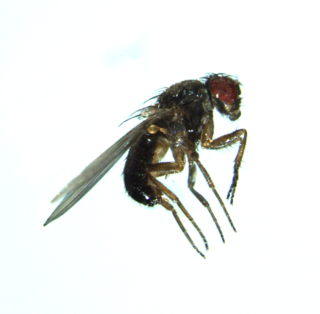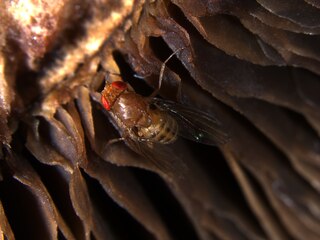Related Research Articles

Thomas Hunt Morgan was an American evolutionary biologist, geneticist, embryologist, and science author who won the Nobel Prize in Physiology or Medicine in 1933 for discoveries elucidating the role that the chromosome plays in heredity.
Calvin Blackman Bridges was an American scientist known for his contributions to the field of genetics. Along with Alfred Sturtevant and H.J. Muller, Bridges was part of Thomas Hunt Morgan's famous "Fly Room" at Columbia University.
Edward Butts Lewis was an American geneticist, a corecipient of the 1995 Nobel Prize in Physiology or Medicine. He helped to found the field of evolutionary developmental biology.
A genetic mosaic, or mosaicism, involves the presence in one individual who has developed from a fertilised egg of two or more genetic populations of cells with different genotypes. Mosaicism has been reported to be present in as high as 70% of cleavage-stage embryos and 90% of blastocyst-stage embryos derived from in vitro fertilization.
Alfred Henry Sturtevant was an American geneticist. Sturtevant constructed the first genetic map of a chromosome in 1911. Throughout his career he worked on the organism Drosophila melanogaster with Thomas Hunt Morgan. By watching the development of flies in which the earliest cell division produced two different genomes, he measured the embryonic distance between organs in a unit which is called the sturt in his honor. In 1967, Sturtevant received the National Medal of Science.

Drosophila simulans is a species of fly closely related to D. melanogaster, belonging to the same melanogaster species subgroup. Its closest relatives are D. mauritiana and D. sechellia.
The Kitanemuk are an indigenous people of California. They traditionally lived in the Tehachapi Mountains and the Antelope Valley area of the western Mojave Desert of southern California, United States. Today some Kitanemuk people are enrolled in the federally recognized Tejon Indian Tribe of California.
Sturtevant may refer to:
The paraphyletic subgenus Sophophora of the genus Drosophila was first described by Alfred Sturtevant in 1939. It contains the best-known drosophilid species, Drosophila melanogaster. Sophophora translates as carrier (phora) of wisdom (sophos). The subgenus is paraphyletic because the genus Lordiphosa and the species Hirtodrosophila duncani are also placed within this subgenus.
The Tataviam language was spoken by the Tataviam people of the upper Santa Clara River basin, Santa Susana Mountains, and Sierra Pelona Mountains in southern California. It had become extinct by 1916 and is known only from a few early records, notably a few words recorded by Alfred L. Kroeber and John P. Harrington in the early decades of the 20th century. These word lists were not from native speakers, but from the children of the last speakers who remembered a few words and phrases.
Tan Jiazhen, also known as C. C. Tan, was a Chinese geneticist. He was an academician of the Chinese Academy of Sciences and a foreign member of United States National Academy of Sciences. Tan was a main founder of modern Chinese genetics.
This is a list of books and monographs by the American geneticist Thomas Hunt Morgan. Morgan produced 22 books on embryology, genetics and evolution. Books are in order by date. Three of Morgan's co-authors have their own articles: Calvin Bridges, Alfred Sturtevant and Hermann Joseph Muller.

Lilian Vaughan Morgan was an American experimental biologist who made seminal contributions to the genetics of Drosophila melanogaster, which cemented its status as one of the most powerful model systems in biology. In addition to her scientific career, she was involved in science education and was one of the founders of the Children's School of Science in Woods Hole, Massachusetts.
William Curtis Sturtevant was an anthropologist and ethnologist. He is best known as the general editor of the 20-volume Handbook of North American Indians. Renowned anthropologist Claude Lévi-Strauss described the work as "an absolutely indispensable tool that should be found on the shelves of all libraries, public and private alike."
Drosophilist is a term used to refer to both the specific group of scientists trained in the laboratory of Thomas Hunt Morgan, and more generally any scientist who uses the fruit fly Drosophila melanogaster to study genetics, development, neurogenetics, behavior and a host of other subjects in animal biology.

The Drosophila obscura species group belongs to the subgenus Sophophora and contains 6 subgroups: affinis, microlabis, obscura, pseudoobscura, subobscura, and sinobscura.
The Genetics Society of America (GSA) is a scholarly membership society of more than 5,500 genetics researchers and educators, established in 1931. The Society was formed from the reorganization of the Joint Genetics Sections of the American Society of Zoologists and the Botanical Society of America.

Drosophila is a paraphyletic subgenus of the genus Drosophila, a classification of fruit flies. This subgenus was first described by Alfred Sturtevant in 1939. Members of the subgenus Drosophila can be distinguished from other Drosophilid species by breaks in the pigmentation along the dorsal section of their abdomen.

Drosophila willistoni is a species of fruit fly. It was originally described by Alfred Sturtevant in 1916. It ranges from Florida, Mexico and Caribbean islands southwards to Argentina and is the most common Drosophilid fruit fly in the Amazon rainforest.

Drosophila subobscura is a species of fruit fly in the family Drosophilidae. Originally found around the Mediterranean, it has spread to most of Europe and the Near East. It has been introduced into the west coasts of Canada, the United States, and Chile. Its closest relative is Drosophila madeirensis, found in the Madeira Islands, followed by D. guanche, found in the Canary Islands. These three species form the D. subobscura species subgroup. When they mate, males and females perform an elaborate courtship dance, in which the female can either turn away to end the mating ritual, or stick out her proboscis in response to the male's, allowing copulation to proceed. D. subobscura has been regarded as a model organism for its use in evolutionary-biological studies.
References
- ↑ William B. Provine (2000). "Alfred Henry Sturtevant and crosses between Drosophila melanogaster and Drosophila simulas". In James Franklin Crow & William F. Dove (ed.). Perspectives on genetics: anecdotal, historical, and critical commentaries, 1987-1998. University of Wisconsin Press. ISBN 978-0-299-16604-5.
| | This article related to members of the fly family Drosophilidae is a stub. You can help Wikipedia by expanding it. |